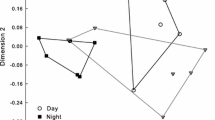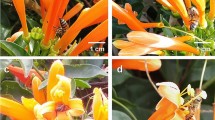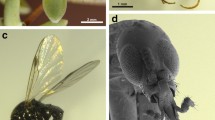Abstract
Flower surfaces play a key role in the interaction with pollinators acting as signals and landing sites to attach to. To test attachment, Carniolan honeybees and greenbottle flies were used. Both species represent pollinators equipped with smooth or hairy tarsal attachment devices, respectively. A combination of microscopic methods and traction force measurements was applied in order to understand and evaluate the efficiency of pollinator attachment to a variety of petal surfaces. Although the petal surface texture influenced the attachment, coevolutionary relationships or adaptations between flower surfaces and pollinator tarsi could not be confirmed. Since pollinators appear to be opportunistic, they are expected to attach to a variety of flower surfaces. Rougher surfaces, including conical and papillate epidermal cells, significantly increased the foothold of flies and honeybees, while flat, tabular epidermal cells covered with microstructures like cuticular folds and epicuticular wax crystals impaired attachment. Carniolan honeybees generated larger forces than greenbottle flies, but the latter showed higher safety factors. However, tendencies in attachment ability toward sufficient and insufficient substrates are similar in flies and bees.








Similar content being viewed by others
References
Al Bitar L, Voigt D, Zebitz CPW, Gorb SN (2010) Attachment ability of the codling moth Cydia pomonella L. to rough substrates. J Insect Physiol 56:1966–1972
Alcorn K, Whitney H, Glover B (2012) Flower movement increases pollinator preference for flowers with better grip. Funct Ecol 26:941–947
Alexander RMCN (1985) The maximum forces exerted by animals. J Exp Biol 115:31–238
Anyon MJ, Orchard MJ, Buzza DMA, Humphries S, Kohonen MM (2012) Effect of particulate contamination on adhesive ability and repellence in two species of ant (Hymenoptera; Formicidae). J Exp Biol 215:605–616
Arnhart L (1923) Das Krallenglied der Honigbiene. Archiv für Bienenkunde 5:37–86
Atkin DSJ, Hamilton RJ (1982) The effects of plant waxes on insects. J Nat Prod 45:694–696
Barthlott W, Ehler N (1977) Raster-Elektronenmikroskopie der Epidermis-Oberflächen von Spermatophyten. Trop Subtrop Pflanzenwelt 19:1–467
Barthlott W, Neinhuis C, Cutler D, Ditsch F, Meusel I, Theisen I, Wilhelmi H (1998) Classification and terminology of plant epicuticular waxes. Bot J Linn Soc 126:237–260
Baur F, Gorb SN (2001) How the bee releases its leg attachment devices. In: Wisser A, Nachtigall W (eds) Technische Biologie und Bionik. 5. Bionik-Kongress, Dessau 2000. Gustav Fisher Verlag, Stuttgart, pp 295–297
Betz O (2002) Performance and adaptive value of tarsal morphology in rove beetles of the genus Stenus (Coleoptera, Staphylinidae). J Exp Biol 205:1097–1113
Beutel RG, Gorb SN (2001) Ultrastructure of attachment specializations of hexapods, (Arthropoda): evolutionary patterns inferred from a revised ordinal phylogeny. J Zool Syst Evol Res 39:177–207
Božič J, Valentinčič T (1995) Quantitative analysis of social grooming behavior of the honey bee Apis mellifera carnica. Apidologie 26:141–147
Bringmann G, Kühn R (1955) Elektronenmikroskopische Befunde zur Morphologie der Cuticula von Blüten gärtnerischer und landwirtschaftlicher Nutzpflanzen. Z Naturforschg 10b:47–58
Bullock JMR, Federle W (2011) The effect of surface roughness on claw and adhesive hair performance in the dock beetle Gastrophysa viridula. Insect Sci 18:298–304
Chittka L, Raine NE (2006) Recognition of flowers by pollinators. Curr Opin Plant Biol 9:428–435
Christensen KI, Hansen HV (1998) SEM-studies of epidermal patterns of petals in the angiosperms. Opera Bot 135:1–91
Conde-Boytel R, Erickson EH, Carlson SD (1989) Scanning electron microscopy of the honeybee, Apis mellifera L. (Hymenoptera: Apidae) pretarsus. Int J Insect Morphol 18:59–69
Cragg JB, Hobart JA (1955) A study of a field population of the blowflies Lucilia caesar (B.) and sericata (Mg.). Ann App Biol 43:645–663
Dai Z, Gorb S, Schwarz U (2002) Roughness-dependent friction force of the tarsal claw system in the beetle Pachnoda marginata (Coleoptera, Scarabaeidae). J Exp Biol 205:2479–2488
Daumer K (1958) Blumenfarben, wie sie die Bienen sehen. Z Vergl Physiol 41:49–110
de Brito Sanchez MG, Lorenzo E, Su S, Liu F, Zhan Y, Giurfa M (2014) The tarsal taste of honey bees: behavioral and electrophysiological analyses. Front Behav Neurosci 8:25
Dirks JH, Federle W (2011) Fluid-based adhesion in insects—principles and challenges. Soft Matter 7:11047–11053
Eigenbrode SD, Jetter R (2002) Attachment to plant surface waxes by an insect predator. Integr Comp Biol 42:1091–1099
Eimüller T, Guttmann P, Gorb SN (2008) Terminal contact elements of insect attachment devices studied by transmission X-ray microscopy. J Exp Biol 211:1958–1963
Eller BM (1985) Epidermis und spektrale Eigenschaften pflanzlicher Oberflächen. Ber Deutsch Bot Ges 98:465–475
Endlein T, Federle W (2015) On heels and toes: how ants climb with adhesive pads and tarsal friction hair arrays. PLoS One 10:e0141269
Erickson EH, Carlson SD, Garment MB (1986) A scanning electron microscope atlas of the honey bee. Iowa State University Press, Ames
Evangelista C, Kraft P, Dacke M, Reinhard J, Srinivasan MV (2010) The moment before touchdown: landing manoeuvres of the honeybee Apis mellifera. J Exp Biol 213:262–270
Faegri K, van der Pijl L (1966) The principles of pollination ecology. Pergamon Press, Oxford
Federle W, Brainerd E, Mc Mahon T, Hölldobler B (2001) Biomechanics of the movable pretarsal adhesive organ in ants and bees. Proc Natl Acad Sci USA 98:6215–6220
Flügel HJ (2013) Blütenökologie, Band 1: Die Partner der Blumen. Die Neue Brehm-Bücherei Band 43. VerlagsKG Wolf, Magdeburg
Frantsevich LI, Gorb SN (2002) Arcus as a tensegrity structure in the arolium of wasps (Hymenoptera: Vespidae). Zoology 105:225–237
Frantsevich LI, Gorb SN (2004) Structure and mechanics of the tarsal chain in the hornet, Vespa crabro (Hymenoptera: Vespidae): implications on the attachment mechanism. Arthropod Struct Dev 33:77–89
Geisert B, Altner H (1974) Analysis of the sensory projection from the tarsal sensilla of the blow-fly (Phormia terraenovae Rob.-Desv., Diptera). Cell Tissue Res 150:249–259
Gladun DV (2008) Morphology of the pretarsus of the sawflies and horntails (Hymenoptera: ‘Symphyta’). Arthropod Struct Dev 37:13–28
Gladun DV, Gorb SN, Frantsevich LI (2009) Alternative tasks of the insect arolium with special reference to Hymenoptera. In: Gorb SN (ed) Functional surfaces in biology: adhesion related phenomena, vol 2. Springer, Berlin, pp 67–103
Gorb SN (2007) Visualisation of native surfaces by two-step molding. Microsc Today 15:44–46
Gorb EV, Gorb SN (2002) Attachment ability of the beetle Chrysolina fastuosa on various plant surfaces. Entomol Exp Appl 105:13–28
Gorb EV, Gorb SN (2006) Do plant waxes make insect attachment structures dirty? Experimental evidence for the contamination. In: Herrel A, Speck T, Rowe NP (eds) Ecology and biomechanics. A mechanical approach to the ecology of animals and plants. CRC Press, Boca Raton, pp 147–162
Gorb EV, Gorb SN (2009) Effects of surface topography and chemistry of Rumex obtusifolius leaves on the attachment of the beetle Gastrophysa viridula. Entomol Exp Appl 130:222–228
Gorb SN, Gorb EV, Kastner V (2001) Scale effects on the attachment pads and friction forces in syrphid flies (Diptera, Syrphidae). J Exp Biol 204:1421–1431
Gorb EV, Voigt D, Eigenbrode SD, Gorb SN (2008) Attachment force of the beetle Cryptolaemus montrouzieri (Coleoptera, Coccinellidae) on leaflet surfaces of mutants of the pea Pisum sativum (Fabaceae) with regular and reduced wax coverage. Arthropod Plant Interact 2:247–259
Gorb SN, Schuppert J, Walther P, Schwarz H (2012) Contact behaviour of setal tips in the hairy attachment system of the fly Calliphora vicina (Diptera, Calliphoridae): a cryo-SEM approach. Zoology 115:142–150
Green PB, Linstead P (1990) A procedure for SEM of complex shoot structures applied to the inflorescence of snapdragon (Antirrhinum). Protoplasma 158:33–38
Grohmann C, Blankenstein A, Koops A, Gorb SN (2014) Attachment of Galerucella nymphaeae (Coleoptera, Chrysomelidae) to surfaces with different surface energy. J Exp Biol 21:4213–4220
Heinrich B (1980) Mechanisms of body-temperature regulation in honeybees, Apis mellifera. II. Regulation of thoracic temperature at high air temperatures. J Exp Biol 85:73–85
Hiller GH (1884) Untersuchungen über die Epidermis der Blüthenblätter. Jb Wiss Bot 15:411–449
Hosoda N, Gorb SN (2011) Friction force reduction triggers feet grooming behaviour in beetles. Proc R Soc Lond B Biol Sci 278:1748–1752. doi:10.1098/rspb.2010.1772
Hrncir M, Barth FG, Tautz J (2005) Vibratory and airborne-sound signals in bee communication (Hymenoptera). In: Drosopoulos S, Claridge MF (eds) Insect Sounds and Communication: physiology, behaviour, ecology, and evolution. CRC Press, Boca Raton, pp 421–436
Kevan PG (1987) Texture sensitivity in the life of honeybees. In: Menzel R, Mercer A (eds) Neurobiology and behavior of honeybees. Springer, Berlin, pp 96–101
Kevan PG, Lane MA (1985) Flower petal microtexture is a tactile cue for bees. Proc Natl Acad Sci USA 82:4750–4752
Knoll F (1926) Insekten und Blumen. Experimentelle Arbeiten zur Vertiefung unserer Kenntnisse über die Wechselbeziehungen zwischen Pflanzen und Tieren, Abhandlungen der zool.-botan. Gesell Wien 12:1–645
Knuth P (1898a) Handbuch der Blütenbiologie, Band 1: Einleitung und Litteratur. Verlag Wilhelm Engelmann, Leipzig
Knuth P (1898b) Handbuch der Blütenbiologie, Band 2: Die bisher in Europa und im arktischen Gebiet gemachten blütenbiologischen Beobachtungen; 2. Teil: Lobeliaceae bis Gnetaceae. Verlag Wilhelm Engelmann, Leipzig
Kobayashi H, Daimaruya M, Fujita H (2003) Unfolding of morning glory flower as a deployable structure. In: Watanabe K, Ziegler F (eds) IUTAM symposium on dynamics of advanced materials and smart structures. Proceedings of the IUTAM symposium, Yonezawa, Japan, 20–24 May 2002, series solid mechanics and its applications, vol 106, pp 207–216
Koch K, Bhushan B, Barthlott W (2008) Diversity of structure, morphology and wetting of plant surfaces. Soft Matter 4:1943–1963
Koch K, Bhushan B, Barthlott W (2009) Multifunctional surface structures of plants: an inspiration for biomimetics. Prog Mater Sci 54:137–178
Koch K, Bennemann M, Bohn HF, Albach DC, Barthlott W (2013) Surface microstructures of daisy florets (Asteraceae) and characterization of their anisotropic wetting. Bioinspir Biomim 8:036005
Kramer E (1976) The orientation of walking honeybees in odour fields with small concentration gradients. Physiol Entomol 1:27–37
Kugler H (1970) Blütenökologie, 2nd edn. Gustav Fischer Verlag, Stuttgart
Kurer GA (1917) Kutikularfalten und Protuberanzen an Haaren und Epidermen und ihre Verwendung zur Differenzialdiagnose offizineller Blätter. Dissertation, Universität Bern
Lee HJ, Zhang S, Meyer RJ, Sherlock NP, Shrout TR (2012) Characterization of piezoelectric ceramics and 1–3 composites for high power transducers. Appl Phys Lett 101:032902
Leonard AS, Dornhaus A, Papaj DR (2011) Forget-me-not: complex floral displays, inter-signal interactions, and pollinator cognition. Curr Zool 57:215–224
Li-Beisson Y, Pollard M, Sauveplane V, Pinot F, Ohlrogge J, Beisson F (2009) Nanoridges that characterize the surface morphology of flowers require the synthesis of cutin polyester. Proc Natl Acad Sci USA 106:22008–22013
Lucas-Barbosa D (2016) Integrating studies on plant-pollinator and plant–herbivore interactions. Trends Plant Sci 21:125–133
Lucas-Barbosa D, Sun P, Hakman A, van Beek TA, van Loon JJA, Dicke M (2016) Visual and odour cues: plant responses to pollination and herbivory affect the behaviour of flower visitors. Funct Ecol 30:431–441
Lukoschus F (1962) Ausbildungsformen von Kutikula und kutikularen Kleinorganen bei der Honigbiene (Apis mellifica L.). Z Morphol Ökol Tiere 51:547–574
Martens P (1933) Origine et rôle des plissements superficiels sur l’épiderme des pétales floraux. Cr Hebd Acad Sci 197:785–787
Meeuse ADJ (1972) Angiosperm phylogeny, floral morphology and pollination ecology. Acta Biotheor 21:145–166
Metzner P (1957) Zur Optik der Blattoberflächen. Genet Resour Crop Evol 5:221–239
Müller L (1929) Anatomisch-biomechanische Studien an maskierten Scrophulariaceenblüten. Österr Bot Z 78:193–214
Niederegger S, Gorb S (2003) Tarsal movements in flies during leg attachment and detachment on a smooth substrate. J Insect Physiol 49:611–620
Niederegger S, Gorb SN, Jiao Y (2002) Contact behaviour of tenent setae in attachment pads of the blowfly Calliphora vicina (Diptera, Calliphoridae). J Comp Physiol A 187:961–970
Nowottnick K (2004) Die Honigbiene 1. Auflage. Die Neue Brehm-Bücherei Band 31. Westarp Wissenschaften-Verlagsgesellschaft, Hohenwarsleben
Ojeda I, Francisco-Ortega J, Cronk QCB (2009) Evolution of petal epidermal micromorphology in Leguminosae and its use as a marker of petal identity. Ann Bot Lond 104:1099–1110
Ojeda DI, Valido A, de Castro AGF, Ortega-Olivencia A, Fuertes-Aguilar J, Carvalho JA, Santos-Guerra A (2016) Pollinator shifts drive petal epidermal evolution on the Macaronesian islands bird-flowered species. Biol Lett 12:20160022. doi:10.1098/rsbl.2016.0022
Owens DK, Wendt RC (1969) Estimation of the surface free energy of polymers. J Appl Polym Sci 13:1741–1747
Papiorek S, Junker RR, Lunau K (2014) Gloss, colour and grip: multifunctional epidermal cell shapes in bee- and bird-pollinated flowers. PLoS One 9:e112013
Peressadko AG, Gorb SN (2004) Surface profile and friction force generated by insects. In: First international industrial conference bionik, VDI Verlag, Düsseldorf, pp 257–263
Pflumm W (1970) Lokalisierendes Schmecken bei Insekten. Z Vergl Physiol 68:49–59
Prüm B, Seidel R, Bohn HF, Speck T (2012a) Plant surfaces with cuticular folds are slippery for beetles. J R Soc Interface 9:127–135
Prüm B, Seidel R, Bohn HF, Speck T (2012b) Impact of cell shape in hierarchically structured plant surfaces on the attachment of male Colorado potato beetles (Leptinotarsa decemlineata). Beilstein J Nanotechnol 3:57–64
Prüm B, Bohn HF, Seidel R, Rubach S, Speck T (2013) Plant surfaces with cuticular folds and their replicas: influence of microstructuring and surface chemistry on the attachment of a leaf beetle. Acta Biomater 9:6360–6368
Schubert K (1925) Zur Kenntnis der Blütenblatt-Epidermis. Bot Arch 12:226–289
Schulmeister S (2003) Morphology and evolution of the tarsal plantulae in Hymenoptera (Insecta), focussing on the basal lineages. Zool Scr 32:153–172
Schulte AJ, Koch K, Spaeth M, Barthlott W (2009) Biomimetic replicas: transfer of complex architectures with different optical properties from plant surfaces onto technical materials. Acta Biomater 5:1848–1854
Schulte AJ, Droste DM, Koch K, Barthlott W (2011) Hierarchically structured superhydrophobic flowers with low hysteresis of the wild pansy (Viola tricolor) - new design principles for biomimetic materials. Beilstein J Nanotechnol 2:228–236
Snodgrass RE (1910) The anatomy of the honey bee. Technical Series No. 18, US Department of Agriculture, Bureau of Entomolgy, pp 1–162
Sprengel CH (1793) Das entdeckte Geheimniss der Natur im Bau und in der Befruchtung der Blumen 1. Auflage. Vieweg Verlag, Berlin
Spurr AR (1969) A low-viscosity epoxy resin embedding medium for electron microscopy. J Ultra Mol Struct Res 26:31–43
Stork NE (1980) Role of waxblooms in preventing attachment to brassicas by the mustard beetle, Phaedon cochleariae. Entomol Exp Appl 28:100–107
Taneda H, Watanabe-Taneda A, Chhetry R, Ikeda H (2015) A theoretical approach to the relationship between wettability and surface microstructures of epidermal cells and structured cuticles of flower petals. Ann Bot Lond 115:923–937
Tautz J (2008) The buzz about bees: biology of a superorganism. Springer, Berlin
Taylor GJ, Paulk AC, Pearson TWJ, Moore RJD, Stacey JA, Ball D, van Swinderen B, Srinivasan MV (2015) Insects modify their behaviour depending on the feedback sensor used when walking on a trackball in virtual-reality. J Exp Biol. doi:10.1242/jeb.125617
Träger B, Große WR (1987) Zur Biologie von Lucilia sericata Meig. (Diptera, Calliphoridae) und deren Nutzung als Bestäuber von Kulturpflanzen. Hercynia 24:153–165
van der Kooi CJ, Wilts BD, Leertouwer HL, Staal M, Elzenga JTM, Stavenga DG (2014) Iridescent flowers? Contribution of surface structures to optical signaling. New Phytol 203:667–673
Vaudo DA, Patch HM, Mortensen DA, Grozinger CM, Tooker JF (2014) Bumble bees exhibit daily behavioral patterns in pollen foraging. Arthropod Plant Interact 8:273–283
Vogel S (1983) Ecophysiology of zoophilic pollination. In: Lange OL, Nobel PS, Osmond CB, Ziegler H (eds) Physiological plant ecology III. Springer, Berlin, pp 559–624
Voigt D, Gorb EV, Gorb SN (2007) Plant surface–bug interactions: Dicyphus errans stalking along trichomes. Arthropod Plant Interact 1:221–243
Voigt D, Schuppert JM, Dattinger S, Gorb SN (2008) Sexual dimorphism in the attachment ability of the colorado beetle Leptinotarsa decemlineata (Coleoptera: Chrysomelidae) to rough substrates. J Insect Physiol 54:765–776
Voigt D, Schweikart A, Fery A, Gorb SN (2012) Leaf beetle attachment on wrinkles: isotropic friction on anisotropic surfaces. J Exp Biol 205:2479–2488
von Frisch K (1949) Die Polarisation des Himmelslichtes als orientierender Faktor bei den Tänzen der Bienen. Experientia 5:142–148
Whitney HM, Chittka L, Bruce T, Glover BJ (2009a) Conical epidermal cells allow bees to grip flowers and increase foraging efficiency. Curr Biol 19:948–953
Whitney HM, Kolle M, Andrew P, Chittka L, Steiner U, Glover BJ (2009b) Floral iridescence, produced by diffractive optics, acts as a cue for animal pollinators. Science 323:130–133
Whitney HM, Bennett KMV, Dorling M, Sandbach L, Prince D, Chittka L, Glover BJ (2011a) Why do so many petals have conical epidermal cells? Ann Bot Lond 108:609–616
Whitney HM, Poetes R, Steiner U, Chittka L, Glover BJ (2011b) Determining the contribution of epidermal cell shape to petal wettability using isogenic Antirrhinum lines. PLoS One 6:e17576
Willmer P (2011) Pollination and floral ecology. Princeton University Press, Princeton
Zhang Y, Hayashi T, Inoue M, Oyama Y, Hosokawa M, Yazawa S (2008) Flower color diversity and its optical mechanism. Acta Hortic 766:469–476
Zhang Y, Sun T, Xie L, Hayashi T, Kawabata S, Li Y (2015) Relationship between the velvet-like texture of flower petals and light reflection from epidermal cell surfaces. J Plant Res 128:623–632
Zhou Y, Robinson A, Steiner U, Federle W (2014) Insect adhesion on rough surfaces: analysis of adhesive contact of smooth and hairy pads on transparent microstructured substrates. J R Soc Interface 11:20140499
Acknowledgements
F. Bachmann (Dresden) kindly provided honeybees. B. Ditsch and colleagues kept the plants in the Botanical Garden of TU Dresden. The team of DataPhysics Instruments GmbH (Filderstadt, Germany) granted access to the SCA 20 Demo software. The study was partially funded by the BMBF Project SPIRED (031A216B).
Author information
Authors and Affiliations
Corresponding author
Additional information
Handling Editor: Heikki Hokkanen.
Electronic supplementary material
Below is the link to the electronic supplementary material.
Rights and permissions
About this article
Cite this article
Bräuer, P., Neinhuis, C. & Voigt, D. Attachment of honeybees and greenbottle flies to petal surfaces. Arthropod-Plant Interactions 11, 171–192 (2017). https://doi.org/10.1007/s11829-016-9478-0
Received:
Accepted:
Published:
Issue Date:
DOI: https://doi.org/10.1007/s11829-016-9478-0




